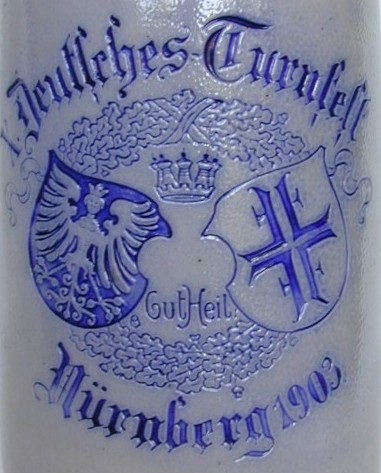|
Stein Collectors International |

by Walt Vogdes |
| This article is a
modified and
condensed version of one written by Dr. Roy DeSelms and published in Prosit,
the journal of Stein Collectors International, in 1978.
Stein collectors, be they novice
or old-hand,
understandably want to know what is written on their steins.
Translation to
English is difficult in its own right, but simply transcribing
the words
written in old German print (in one of many Fraktur
fonts) can be
daunting. If you don't think this is a problem, just look at the
questions asked
in SteinTalk, or in the listings of steins for sale on eBay.
It's really
no wonder that figuring out what those letters actually are is so
difficult -
use of these alphabets was being discontinued in German schools in the
late
1930's, and completely ended in the 1940's. Consequently, your 50-year
old
German cousin or brother-in-law is quite possibly not familiar with
this
alphabet. |
|||
| A a |
This article uses the FetteFraD font to illustrate the old German lettering. This type of font is most commonly found on hand-lettered regimental steins, but is also occasionally found in verses or banners on other types of steins. The old German letter set is shown down the left margin of this article, with Roman equivalents. The first thing to note is that there are 30 letters provided, 29 in both upper and lower case, plus one (the last one in the table) only in lower case, not the standard 26 that we are accustomed to dealing with. Where do the extra ones arise?
Ooops, something else you may notice. There are two flavors of small s (bringing the total number of lower case letters to 31). What’s this about?
A very common example of the usage of both double s ("ess-zet") and the closing s ("schloos s") is given in figure 2 in the familiar "Greetings from Munich". By now you must recognize that transcription must be done with a sensitivity to the surrounding letters and the position of the letters within the word. Ooops, upon taking a closer look we discover that the capital letters I and J are the same! I’ll leave it to the philosophers to figure out if this means we have 29 or 30 upper case letters, but how do we distinguish them?
We’re finally done with the inventory of old German letters which is shown to the left. Unfortunately, there is still one very common and important convention in German writing that has the effect of adding even more letters to the old German alphabet.
That’s all there is to explaining the inventory and usage of the old German print alphabet, but let’s take a closer look at some problem areas. Upper case B, P and V all look similar:
One "true life" example is taken from a 4F stein (right). Context plus the chart at the left allows us to transcribe this as "X. Deutsches Turnfest, Nuernberg 1903". Now that the necessary tools have been provided to allow transcription, you’ve got at least a fighting chance at getting a translation. |
||
| Ae ae | |||
| B b | |||
| C c | |||
| D d | |||
| E e | |||
| F f | |||
| G g | |||
| H h | |||
| I i | |||
| J j | |||
| K k | |||
| L l | |||
| M m | |||
| N n | |||
| O o | |||
| Oe oe | |||
| P p | |||
| Q q | |||
| R r | |||
| S s | |||
| T t | |||
| U u | |||
| Ue ue | |||
| V v | |||
| W w | |||
| X x | |||
| Y y | |||
| Z z | |||
 |
ss | ||
 Careful
examination of these letters, an understanding of when the special
characters
were used, and a sensitivity to the context of the words or phrase you
are
trying to transcribe will normally do the trick. Also keep in mind that
the
letter set shown in this article is only one of many that were used, so
expect
to find variations.
Careful
examination of these letters, an understanding of when the special
characters
were used, and a sensitivity to the context of the words or phrase you
are
trying to transcribe will normally do the trick. Also keep in mind that
the
letter set shown in this article is only one of many that were used, so
expect
to find variations.